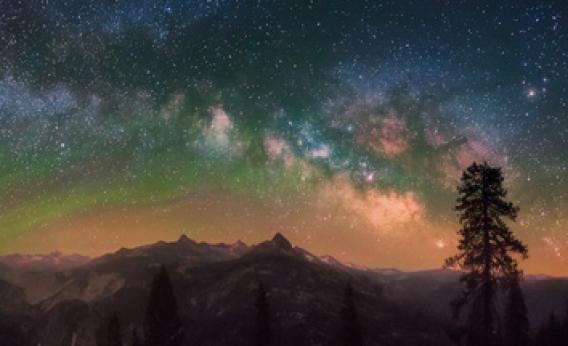Create a free profile to get unlimited access to exclusive videos, sweepstakes, and more!
Valley of the Cosmos

Photographer Michael Shainblum is a wonder. His photographs are just stunning, one after another. I’ve been following his work for years, and every time he posts something it’s awe-inspiring.
Oh, you want an example? Then how about this for your eyeballs?
He titled that one “Valley of the Cosmos,” which is pretty much on the button. The “valley” in this case is Yosemite Valley—see Half Dome in the center?—and the “cosmos” bit is obvious enough.
… or is it? In this view, a panorama, the Milky Way spans the frame. Our galaxy is a thick disk, and we’re inside it, so we see it as a broad splash across the sky. The central region bulges outward, and that can be seen off to the right. The colors are interesting; probably not what your eye would see, but that happens when the contrast is stretched in a photo when you’re trying to bring out faint details. Still, very pretty.
The orange glow is from humans; the horizon commonly shows light pollution from towns sometimes hundreds of kilometers away.
But what the heck is that green glow? You might guess it’s the aurora—a few people on Facebook did think that, in fact, when he posted the picture—but it’s not. Shainblum was facing roughly northeast when he took this photo from Glacier Point, southwest of Half Dome. The aurora would be mostly to the left in this frame if that's what it were.*
That emerald radiance is actually airglow. During the day, sunlight hits atoms and molecules in the upper atmosphere, 100 kilometers above the Earth’s surface. The energy can be stored, then released slowly at night in a process called chemoluminescence. Green is a strongly favored color due to oxygen atoms (similar to why many aurorae are green).
And the ripples? Even at that height, the air is subject to wind and flows. Those ripples are called “gravity waves” (not to be confused with gravitational waves), which I’ve written about before:
The rippling is due to gravity waves. This is simply an up-and-down oscillation of something under the influence of gravity. For example, waves on the surface of the water in your bathtub are gravity waves; the water gets pushed up a little bit (maybe when you plop your rubber ducky into the water), and then gravity pulls that crest of water back down. But the water itself pushes back, and you get oscillatory motion.
This can happen in air, too (air is a fluid, after all). Currents of air in the upper atmosphere bob up and down pretty often, similar to the water in your tub. This motion can disturb the process that creates airglow, so you get those rippling waves moving across the sky.
I love how perspective makes those parallel ripples in Shainblum’s photo appear to converge on the horizon, right behind Half Dome! You couldn’t hope for a better bit of placement.
More of Shainblum’s photography can be found on his website, on 500px, on Facebook, and on Instagram. Treat yourself, and go take a look. Everyone could use a little more beauty in their world.
*Correction, April 27, 2016: I originally misstated that Shainblum was facing south when he took this shot.


























